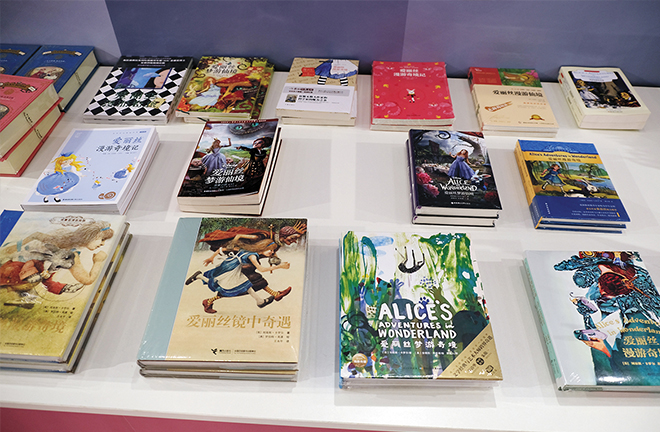Seminar interprets role of females in foreign literature

The “Alice” series of works on display Photo: CNSphoto
On March 10, Zhengzhou University hosted the first Mei Lake Forum on Female Scholars in Foreign Literature Studies in Zhengzhou, Henan Province. Participating female scholars exchanged views on female-related experience, as well as colonialism and sentimentalism in foreign literature.
Rich reflections
“In the history of foreign literature, the shaping of female characters and the prominence of female writers have received growing attention,” said Zhang Shengzhen, a professor from the Faculty of Foreign Studies at Beijing Language and Culture University. Worldwide, self-conscious children’s literature began with the “Alice” series, which continues to exert a significant impact on the image building of girls generations later. The image of girls in children’s literature contains the labels of child, gender, and ethnicity, and its evolution features social and historical manifestations, from Alice in Alice in Wonderland and Through the Looking-Glass, and What Alice Found There, the March sisters in Little Women, Anne in Anne of Green Gables, Dorothy Gale in The Wizard of Oz, Tenar, who guards the Tombs of Atuan in The Earthsea Cycle, Hermione Granger in Harry Potter, Katniss Everdeen in The Hunger Games, to Starr Carter in The Hate U Give. Mirroring the living conditions of girls over the past century, these images facilitate the understanding of ourselves as humans and the development of civilizations.
Female image building in foreign literature and the conscious construction of female writers are not isolated gender topics, but mirror various intricate social issues in the West. Since the early 19th century, Sarah Baartman, born in present-day South Africa, was shaped by Europeans as a “semantic symbol” of the “black Venus.” According to Wang Zhuo, dean of the School of Foreign Languages at Shandong Normal University, the image has gradually evolved from a symbol of black women in the early 19th century to a national symbol in the 21st century. Under the public gaze, the popular stereotype of African women gradually took shape. Behind the production process of the stereotypical “black Venus,” there is the confrontation of cultures, races, ideologies, and cognitive approaches. The power relations of “gaze” are manifested in the underlying writing power and ethics of representation. The creation activities of female African poets represent that the writing of “black Venus” awakens from the gaze and generates a certain oppositional gaze.
“Reflections on social issues contribute to dialogues between varying artistic expressions,” said Wang Hui, a professor from the School of English Studies at Dalian University of Foreign Languages. The title of black British writer David Dabydeen’s fiction A Harlot’s Progress comes from a series of namesake paintings by William Hogarth. The main characters, plot, and the appearance of Hogarth himself in the story all direct to the correlation between with Hogarth’s works and the ekphrastic features in the novel. The female images of black slaves, Jewish doctors, and lower-class women in the novel are all echoes of 18th-century British ideology and stereotypical reproductions of cultural others. Dabydeen’s novel, by way of ekphrasis, forms a dialogue with the works of Hogarth and other British painters, disclosing how they shaped the images of black people and what they intended to achieve in their works, in an attempt to subvert these stereotypes.
Paths of analysis
In recent years, feminism, sentimentalism, and the review of historical culture have enriched analytical paths for foreign literature studies. The relationship between body and mind constitutes an important proposition in the history of Western thought; emotion and reason also contribute an eternal tension in literary creations. Jin Wen, a professor from the Department of Chinese Language and Literature at East China Normal University, noted that in the 18th-century West, the theory of emotion developed rapidly and exerted great impact on social culture. The period was not only an “age of reason,” but also an “era of emotion.” Varying substantially from previous and later eras, the theory of emotion in the 18th century was a significant transition in the history of Western thought and literature. It outlined the utopian vision of Western modernity while foreseeing its fatal paradox.
Chen Rong, a professor at Beijing Foreign Studies University, analyzed foreign literary trends in the 18th and 19th centuries from an auditory perspective. Emerging in the late 18th century, Gothic literature was an important school of British literature at the time. Amid Gothic aesthetic discussions, visuality is a popular topic. Chen noted that the process of the birth, rise, and paradigmatic evolution of Gothic novels is also an expansive process of aural poetics. In the auditory world constructed by classical Gothic novelists such as Horace Walpole, Ann Radcliffe, Charles Brockden Brown, and Edgar Allan Poe, the auditory nature has not merely an aesthetic sense, but also profoundly concerns the issues of body, imagination, reason, and sensibility, expressing the stirring voice of the intersected Enlightenment and Romanticism.
Since modern times, scientific fantasies and inspirations in science fiction have found favor with literary researchers, and the “cyberpunk” New Wave science fiction movement led by writers has profoundly influenced culture. Jin Bing, a professor at the School of International Studies at the University of International Business and Economics, noted the rapid rise of steampunk as another form of science literature since the 1980s. It serves as a representative of “soft science fiction” due to its fantasy of alternate history of the 19th-century technological revolution and its constant focus on the relationship between human and technology (machines). Unlike purely futuristic cyberpunk, steampunk is based on the present and triggers a reevaluation and criticism of previously discarded forms, transforming the past into a vision that evaluates the present, and embodying retro-futurism. The natural and inherent paradoxes of steampunk constitute the tension of its novels.
Edited by YANG LANLAN
